Toradex specialises in designing and producing ARM and x86 embedded computer module hardware and software. Our products deliver high performance at a low power consumption. Designed and developed in Switzerland, to ensure availability and product...
Don't wanna be here? Send us removal request.
Text
Webinar: Build your own Embedded Carrier Board, easily!
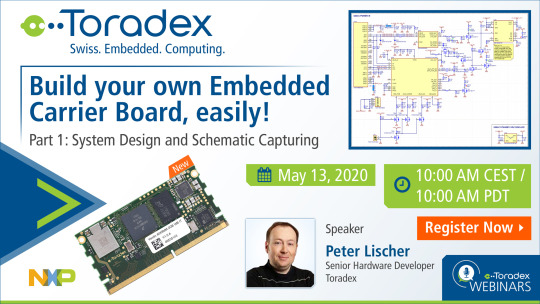
In this webinar, we show you how easy it is to design your own embedded carrier board for Toradex's computer on modules. We begin by showing the differences between the Toradex computer on module families with a focus on the new Verdin computer on module family.
We will guide you through the wide range of reference schematics and design guides provided by Toradex.
The Toradex Pinout Designer is a powerful tool for configuring the pin muxing of Colibri, Apalis, and Verdin modules. The tool allows comparing the interface of different modules. In this webinar, we are introducing the new cloud-based version and walk you through the different features.
We are going to provide insights on selecting the right components for a design with long-term availability. Finally, we reveal how Toradex does schematic reviews on the base of a netlist base. This has proven to be a key factor in getting the first version right.
Key takeaways:
Mastering the selection of the best suitable Toradex computer on module for your next project
Get to know the Toradex reference designs
Understand the functions of the Pinout Designer
Get a front-row seat to Toradex hardware developers revealing how they do component selection and schematic reviews
Have your questions answered by hardware development experts
Grab your free registrations now: https://www.toradex.com/webinars/build-your-own-embedded-carrier-board-easily
Date and Time:
Europe/Asia - Wednesday, May 13, 2020, 10:00 A.M. - 11:00 A.M. (CEST)
Americas - Wednesday, May 13, 2020, 10:00 A.M. - 11:00 A.M. (PDT)
Speakers:
Peter Lischer, Senior Hardware Developer, Toradex
Venue: Online Webinar
#Toradex Webinar#Embedded Carrier Boards#Development Boards#Embedded Boards#Evaluation Boards#Arm Boards
0 notes
Text
Webinar: Creating GUI for Toradex modules with TotalCross Open Source SDK

Are you interested in providing the same excellent user experience (UI/UX) on your embedded device as you are used to from smartphones?
TotalCross is providing an easy-to-use way to build attractive Graphical User Interfaces (GUI) providing high performance even on resource-constrained devices.
During this webinar, you will learn more about the TotalCross Open Source SDK, and understand step-by-step how to create the GUI for Embedded Linux using Java or Kotlin. We will use different System on Modules from Toradex featuring the NXP i.MX 8 and i.MX 6 applications processors. We will also highlight the integration with Torizon open-source easy-to-use Linux from Toradex.
If you are still working on Windows Embedded Compact / WinCE, TotalCross allows you to build an application that you can run on WinCE, while being easy to move to Linux in the future.
Key takeaways:
How to simple create modern and intuitive GUIs with TotalCross for Embedded Linux Devices
Experience the integration with Torizon
Learn about successful deployments from TotalCross
Use the live Q&A to interact with our experts
Grab your free registrations now: https://www.toradex.com/webinars/gui-for-toradex-modules-totalcross-open-source-sdk
Date and Time:
Europe/Asia - Wednesday, April 08, 2020, 01:00 P.M. - 02:00 P.M. (CEST)
Americas - Wednesday, April 08, 2020, 10:00 A.M. - 11:00 A.M. (PDT)
Speakers:
Lucas Galvanini, CMO, TotalCross
Fábio Sobral, Developer Advocate, TotalCross
Daniel Lang, CMO, Toradex
Venue: Online Webinar
0 notes
Text
Webinar: Python in One Hour
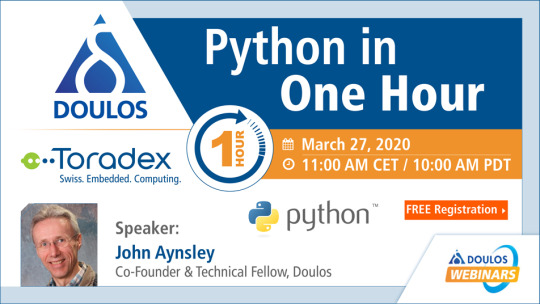
Python has become enormously popular as a programming language because it's so quick-and-easy to use. People often remark that a Python program looks like pseudo-code, an English language description of what the code is meant to do. Python is widely used for scripting tool flows, for software test, and for automating small tasks, as well as for web programming and scientific computing. It has even been used for electronic system modeling and digital hardware verification.
This webinar will get you started with Python. You can expect to learn about:
The basics of the Python language
What makes Python different from other programming languages
The richness of the Python libraries and add-on packages
Grab your free registrations now: https://www.doulos.com/content/events/Python_One_Hour_TDX.php?pk_campaign=TDXWB
Date and Time:
Europe/Asia - Friday, March 27, 2020, 11:00 A.M. - 12:00 P.M. (CET)
Americas - Friday, March 20, 2020, 10:00 A.M. - 11:00 A.M. (PDT)
Speakers:
John Aynsley, Co-Founder & Technical Fellow, Doulos
Venue: Online Webinar
0 notes
Text
Webinar: Simplify Modern Product Development with the Verdin iMX8M Mini and Nano SoMs
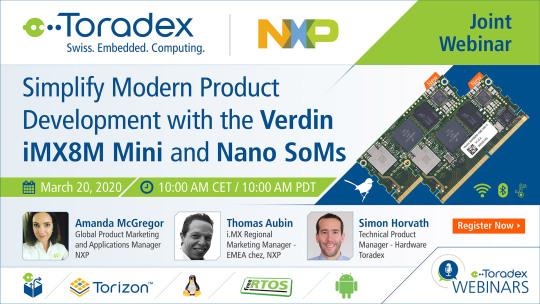
Verdin is Toradex's latest System on Module family. It brings an updated interface to the already successful Colibri and Apalis SoM families. In this webinar, you will learn how Verdin can simplify the development of your next product. First, we will take you through the most notable features of the new Verdin form factor. Next, we will give you a behind-the-scenes look at and insights into the design decisions and market research which led us to develop this new future-proof form factor. We will provide you with a closer look at the first Verdin SoMs featuring the NXP® i.MX 8M Mini / Nano applications processors and Amanda McGregor from NXP will guide us through the details of the processors.
Key Takeaways:
Experience how Verdin simplifies modern product development
Learn about Verdin and its key features
Understand the engineering decisions behind Verdin
Learn how the NXP i.MX 8M Mini and Nano compare to other solutions in the market
Have your questions answered by experts from NXP and Toradex
Grab your free registrations now: https://www.toradex.com/webinars/introducing-verdin-imx8m-system-on-module
Date and Time:
Europe/Asia - Friday, March 20, 2020, 10:00 A.M. - 11:00 A.M. (CET)
Americas - Friday, March 20, 2020, 10:00 A.M. - 11:00 A.M. (PST)
Speakers:
Amanda McGregor, Global Product Marketing and Applications Manager, NXP
Thomas Aubin, i.MX Regional Marketing Manager - EMEA chez, NXP
Simon Horvath, Technical Product Manager - Hardware, Toradex
Venue: Online Webinar
#Verdin Family#NXP i.MX 8 Mini#NXP i.MX 8M Nano#System on Module#Computer on Module#Verdin Launch#Verdin System on Modules
0 notes
Text
Webinar: Jumpstart cloud-connected computer vision and ML designs
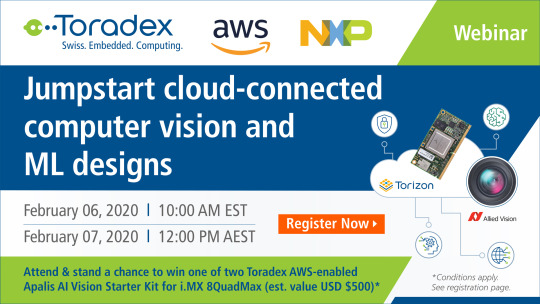
Deep Learning and artificial intelligence (AI) advancements enable manufacturers to leverage many new vision-based capabilities to control quality, manage supply and demand, classify and sort, and ground-truth validation for factory and process automation. AWS, Toradex, and NXP are collaborating to simplify the development of computer vision and machine learning solutions for IoT devices at the edge, even when the cloud connectivity is not available. This webinar demonstrates the Toradex Apalis AI Vision Starter Kit with NXP i.MX 8QuadMax Application Processor. This kit allows you to quickly recognize different kinds of objects leveraging AWS SageMaker Neo and AWS IoT Greengrass. The same platform can then be quickly retrained to recognize any object, even if it is in motion.
The AI Vision Starter Kit includes a camera and a Toradex System on Module that identifies and classifies objects, such as on an assembly line. This kit uses industrial-grade hardware and software that can be the starting point for your next project. The optimized machine learning model runs on the local device, with cloud connectivity for remote maintenance, business tool access and over-the-air (OTA) updating. We use the Linux-based Torizon platform and AWS IoT Greengrass to connect to the cloud via MQTT.
Key Takeaways:
Jumpstart your vision-enabled, connected device development
Learn about the newest hardware and software architecture for Industry 4.0 devices
Experience how the Toradex Apalis System on Modules simplify development with NXP i.MX 8QuadMax processors
Leverage AWS SageMaker Neo to optimize a Deep Neural Network that runs at the edge
Utilize AWS IoT Greengrass to connect to cloud services
Attendees who complete the full registration details and attend, will be entered for the chance to win one of two AWS-enabled AI Vision Starter Kits (estimated value USD $500)*.
Grab your free registrations now: https://register.gotowebinar.com/rt/6695606203214368514?source=Toradex
Date: February 06, 2020
Speakers:
Alexandra Dopplinger, Industrial Marketing Manager, NXP
Karthik Ranjan, Strategic Partner Manager, AWS
Daniel Lang, CMO, Toradex
Venue: Online Webinar
#Machine Learning#Computer Vision#Amazon Web Services#NXP#NXP i.MX 8QuadMax#System on Module#AI Vision Starter Kit
0 notes
Text
Getting Started with Yocto: Meeting the challenge of Embedded Linux deployment

Toradex's partner, Doulos, brings forth an interesting training webinar, which delves into how a minimal Linux system can be extended to include custom, packaged software. Doulos demonstrates how standard Linux tools, such as gdbserver or the Target Communication Framework agent (TCF agent), drops out of the build system and can be used in a stand-alone SDK. In the process, key concepts of the Yocto Project build system such as recipes, tasks and layers will be introduced. A board from the Toradex Colibri Arm family of System on Modules will be used as an example platform.
The webinar covers the following topics:
Managed Linux distributions
The Yocto build system
Creating custom software packages
Application development and systems development SDKs
Example BSP support
Grab your free registrations now: https://www.doulos.com/content/events/intro_to_yocto_tdx.php?pk_campaign=TDXWB#sched
Date and Time:
Europe/Asia - Tuesday, November 26, 2019, 11:00 A.M. - 12:00 P.M. (CET)
Americas - Tuesday, November 26, 2019, 10:00 A.M. - 11:00 A.M. (PST)
Speaker:
Adrian Thomasset, Sr. Member Technical Staff, Doulos | Yocto Expert
Venue: Online Webinar
0 notes
Text
Build your own OTA-updatable Embedded Linux Distribution from Prototype to Production
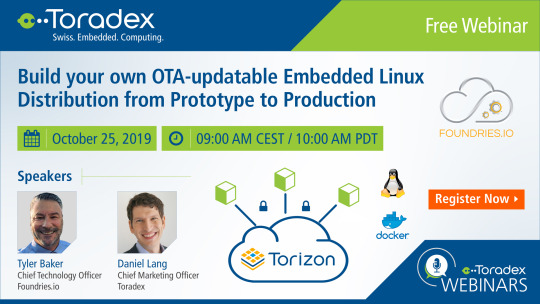
The world of embedded Linux is changing rapidly, and being able to update every piece of software over-the-air (OTA) is fast becoming a requirement industry-wide. This brings more complexity to an already complex market, and many are wondering how to approach this issue without reinventing the wheel each time.
In this session, we will demonstrate how Torizon can be used with Foundries.io to securely build, deploy, and test an embedded product for the duration of its deployment. By the end of the session, you will understand how to integrate Foundries.io OTA services with Torizon, produce a platform image, test it on hardware, and deploy it to devices in the field.
Grab your free registrations now: https://www.toradex.com/webinars/build-your-own-ota-updatable-embedded-linux-distribution
Date and Time:
Europe/Asia - Friday, October 25, 2019, 09:00 A.M. - 10:00 A.M. (CET)
Americas - Friday, October 25, 2019, 10:00 AM - 11:00 AM (PDT)
Speakers:
Tyler Baker, Chief Technology Officer, Foundries.io
Daniel Lang, Chief Marketing Officer, Toradex
Venue: Online Webinar
0 notes
Text
Getting Started with System on Modules, and Torizon - an Industrial Linux Platform
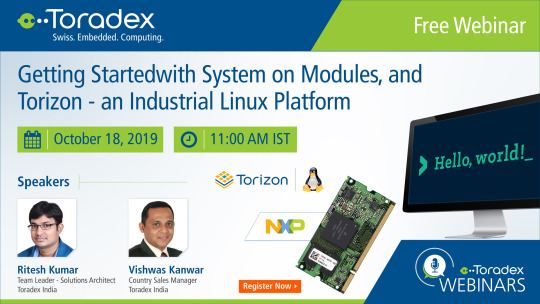
Linux is highly customizable and offers a large ecosystem. Unfortunately, the flexibility comes with a price, Linux on an embedded system is often not that easy-to-use and has a steep learning curve.
In this webinar, we will show you how to get started with embedded Linux and Arm®-based System on Modules, and also introduce you to Torizon - a new easy-to-use Industrial Linux Software Platform.
We will also take you through setting up the hardware until your first “Hello, world!”.
Grab your free registrations now: https://www.toradex.com/webinars/getting-started-with-toradex-system-on-modules-and-torizon
Date and Time:
India - Friday, October 18, 2019, 2019 11:00 A.M. - 12:00 P.M. (IST)
Speakers:
Ritesh Kumar, Team Leader - Solutions Architect, Toradex India Vishwas Kanwar, Country Sales Manager, Toradex India
Venue: Online Webinar
0 notes
Text
The Motivation Behind Toradex Embedded Linux BSP 3.x
We recently released our Embedded Linux BSP 3.0 beta, and we would like to provide you some insights into our motivation for the changes and new features in BSP 3.x
The primary reason for the jump from 2.8 directly to 3.0 is that our Embedded Linux BSPs 3.x will no longer be based on the Ångström distribution. We have used the Ångström distribution for many years to provide a simple out-of-the-box experience that includes a desktop environment, to help with initial steps and to simplify development. It was never intended to be directly deployed to volume products.
With the introduction of Torizon, we now provide a superior out-of-the-box experience. Torizon is intended to be directly deployed into final products. It provides the Docker container runtime, offering access to a multitude of userspace and application environments. It also supports Toradex’s tools, such as our Flash Analytics Tool. Torizon even comes with a Debian-based default container that gives you access to thousands of prebuilt packages in a familiar Debian environment, so you can get started fast.

We typically recommend Torizon to customers who are not familiar with the Yocto Project. Experienced Yocto Project developers will find BSP 3.x to be very closely aligned with Poky, the Yocto Project reference distro. Thus, it provides you with an ideal starting point for your own custom Linux build.
This BSP also includes updated bootloaders and kernels. We moved to OpenEmbedded Thud and Yocto Project 2.6.
BSP3.x is supported on Apalis TK1 and all our i.MX-based products. On the Colibri VF50, VF61, T20 and T30, and on the Apalis T30, we will continue maintaining our long-term supported (LTS) BSP 2.8. We will provide updates in the event of hardware changes, and we will regularly fix critical bugs.
You can find more information about long-term support on our developer webpage.
To keep track of updates and get email notifications, we highly recommend subscribing to updates with our new Get Update feature, on the BSP Roadmap Page.
Please note that BSP 3.0 beta 1 was released for the Apalis iMX8QM only. The upcoming BSP 3.0 beta 2 will support all i.MX-based products and the Apalis TK1.
If you have any questions, please don’t hesitate to contact us. You can post in our community forum or contact our technical support teams directly.
0 notes
Text
Ethernet Compliance Testing at Toradex
Introduction
Toradex offers robust and reliable embedded systems, which are required to work continuously in harsh environments. Ethernet is one of the most important interfaces for the Internet of Things (IoT). We will review some Ethernet standards and show you how Toradex tests for compliance with them.
After looking at the standards, we’ll describe our test configuration, test procedures, and the test results. A Colibri iMX6ULL SoM and Iris Carrier Board were used in this example, but you can use this as a model for testing custom carrier boards if that testing will be part of your verification process.
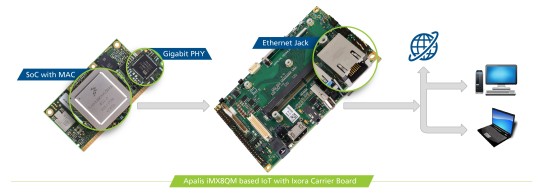
Why We Use Standards and Do Compliance Testing
Ethernet designs adhere to the IEEE 802.3 standard, which defines the Physical and Data Link layer of the seven-layer Open Systems Interconnection (OSI) model. Waveform characteristics are specified in the standard. Designing to this standard allows compatibility and interoperability with other devices, in all kinds of environments all over the world. Otherwise, transmission issues and data losses are likely to occur. Compliance testing ensures that the implementation meets the standard.
In addition to the waveform characteristics specified in the IEEE 802.3 standard, the University of New Hampshire InterOperability Laboratory (UNH-IOL) has provided standard conformance test procedures for those signals.
The documents can be found at these links:
https://ieeexplore.ieee.org/browse/standards/get-program/page/series?id=68
https://www.iol.unh.edu/
Ethernet Physical Layer Basics
The Ethernet standard is several thousand pages, so we’ll just cover the most important concepts and some key terminology.

Figure 1 OSI Reference Model from IEEE Standard for Ethernet
Let’s start with the physical medium. Signals typically arrive through a twisted pair copper cable to an Ethernet jack with magnetics on our Carrier Board, then continue through impedance matched differential traces on the PCB to the Ethernet PHY IC. This device converts analog signals from the medium to digital signals for the processor and vice versa.
The electrical signals first encounter the Medium Dependent Interface (MDI) of the PHY, a part of the Physical layer. Different physical media have different characteristics. In accordance with the specific kind of the media, the signals are transformed and sent to the next layer of the OSI-model, the Data Link Layer. We provide 10Base-T and 100Base-TX (Fast Ethernet) on our Colibri Modules and 1000Base-T (Gigabit) on the Apalis modules. The standardized interface between the first two OSI-layers is called Media Independent Interface (MII) and is independent of the physical layer.
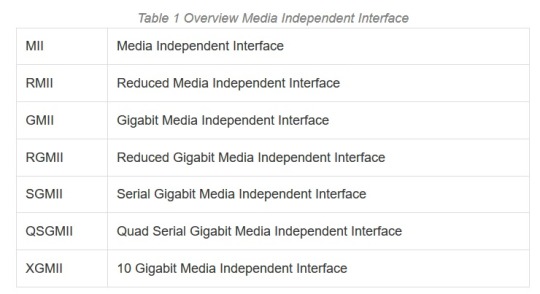
Meanwhile, we are talking about the advanced backward-compatible Reduced Gigabit Media Independent Interface (RGMII) and the next interface for the 10 Gigabit is already named as XGMII. Reduced means that there are fewer signals needed for the same standard. The xMII’s are parallel data buses. There is a supplementary serial bus for management purpose called Management Data Input/Output (MDIO). The xMII interface ends at the Media Access Control (MAC) layer. Here the well-known MAC address is used as a unique identifier. The MAC layer can be integrated with the System on Chip (SoC), like on NXP® processors. But it could be already embedded in the same IC as the PHY, which is better known as an Ethernet Controller. The Ethernet Controller IC, in turn, is connected with the SoC through a separate interface like USB or PCIe. Note that we are not looking at higher OSI layers and protocols like ARP, NDP, IP, TCP, UDP, etc., which are organized in frames and packages, because for all these protocols the electrical characteristics on the first physical levels are the same!
For now, let’s go back to the physical layer. There are 2 main characteristics of the physical link I’d like to expand on, namely, speed and duplex mode. Our modules support speeds up to 1Gbit on Apalis Modules and 100Mbit on Colibri Modules, and both half and full duplex modes. In full duplex mode of operation, PHYs on both ends of the link can communicate with each other simultaneously. For the half duplex mode, where the PHY can’t receive and transmit data at the same time, there need to use the Carrier Sense Multiple Access with Collision Detection (CSMA/CD) to avoid collisions and control the data flow.
As already described, our Apalis Modules are capable of Gigabit Ethernet, but how do the communication partners know with which speed they can send the data? An-auto negotiation procedure exists, where the linking partners set the best link trough 16ms link pulses. Please be careful with auto-negotiation settings, as there is a well-known problem of the duplex mismatch, when the linking partners are configured in a fixed way. On the electrical side of the physical layer 10Base-T and 100Base-TX use two twisted pairs while 1000Base-TX uses 4. 100Base-TX is faster than 10Base-T based on the much faster frequency of 62.5 MHz instead of 10 MHz and denser signal modulation scheme (PAM-3). 1000Base-TX uses the same frequency as 100Base-TX, but transmits across 4 twisted pairs and with a higher level of modulation (PAM-5). Finally, there is an additional feature called EEE, Energy Efficient Ethernet. The aim of this standard is to save energy.
https://www.analog.com/media/en/technical-documentation/application-notes/EE-269.pdf
https://en.wikipedia.org/wiki/Duplex_mismatch
https://en.wikipedia.org/wiki/Media-independent_interface
https://www.asix.com.tw/new_alias.php?alias=93&full=http://www.embedded.com/design/202804534
The picture below summarizes the Ethernet possibilities on the Toradex SoM approach:
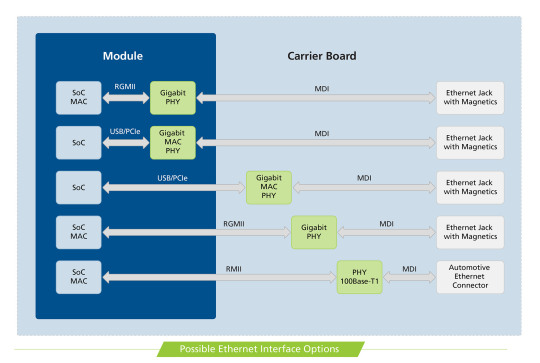
Automotive Ethernet
Before we continue to the Compliance Testing, I want to quickly let you know that I receive a lot of questions about 100Base-T1, better known as Automotive Ethernet. The customers want to know, if it is possible to connect Automotive Ethernet to a fast Ethernet PHY. The 100Base-T1 has a different physical layer specification to fulfill the requirements in a harsher automotive environment. It is not possible to connect it, but the MII is still the same! The solution is to connect the 100Base-T1 PHY to the Multimedia Independent Interface of the SoC directly. Consequently, a Module with an xMII on the Module Edge Connector must be selected! Of course, you have to design your Custom Carrier Board with a 100Base-T1 PHY. Here you can find the list of Toradex Modules which provide an xMII on the edge connector. Please note that this is not a Standard Toradex Interface and the pin assignment varies with each module.
Apalis iMX8
Colibri iMX8X
Colibri iMX7
Colibri iMX6ULL
Colibri Vybrid
Ethernet Compliance Testing for Toradex Systems

Figure 2 10Base-T Test: DOV Internal MAU Normal
After this very short overview, I want to continue with the compliance testing, where we test the electrical signals in time and voltage. The electrical signals look totally different for the 10/100/1000 Mbps and have different requirements as you can see in the oscillograms.
The tests evaluate the voltage amplitudes, jitter values, rise/fall times and other signal characteristics. For each test a defined test signal must be generated by the DUT, e.g. a continuous pseudo-random signal has to be emitted. The easiest way to test the signal requirements is to define a test mask. The signals must not intersect with the mask in order to fulfill the specification. The 10Base-T tests are very often defined through a test mask, as you can see in the first figure. I want to mention some values: The Peak Differential Output Voltage must be between 2.2 V and 2.8 V. The Differential Output Voltage Harmonics must be greater than 27 dB and all Jitter values must be smaller than 22 ns. Very interesting is the twisted-pair model for 10Base-T, which must be used for some compliance tests. With the equivalent circuit based on lumped elements, it is possible to model multiple different transmission elements with just passive components. Depending on the PHY a linking partner is needed for 10Base-T compliance tests. You can download the Test Report of Colibri iMX6ULL as an example, where you can find all tests.

Figure 3 Measured differential random 10Base-T signal without load
The interface characteristics for 100Base-TX are defined in table 2 based on the MLT-3 voltage signals with three levels. The data is encoded before with 4B5B algorithm, so a clock recovery out of the data stream is possible because a level transition is forced. For our test equipment, a pseudo-random test pattern (PRBS7) is enough for all the tests. However, some tests only trigger on defined patterns and measures only at that moment the specific values.
Table 2 Interface Characteristics 100Base-TX Characteristics Min Max Unit UTP DOV Base to Upper/Lower 950 1050 mV Signal Amplitude Symmetry 98 102 % Rise/Fall Time 3 5 ns Rise/Fall Time Symmetry 0 500 ps Duty Cycle Distortion -250 250 ps Transmit Jitter 0 1.4 ns Overshoot 0 5 %

Figure 4 Measured differential random signal 100Base-TX
The test criteria are defined in a similar manner for the 1000Base-T. I am not going to list them. For these tests an additional disturber in the form of an Arbitrary Waveform Generator (AWG) is needed to create the required disturbing signals with the frequency of 31.25 MHz and 20.833 MHz. In figure 5 you can see the test pattern of test mode 1 produced by the PHY. There are four different test patterns, which can be generated through PHY’s MDIO register settings. Please don’t forget that we have to perform the compliance test four times, because of the four twisted pairs.

Figure 5 Definition of Test Mode 1 Waveform 1000Base-T from IEEE Standard for Ethernet

Figure 6 Measured differential Test Mode 4 Distortion Test 1000Base-T without disturber
We have now seen some of the electrical requirements that must be fulfilled to be compliant with the interface definition. Before we have a closer look at the test equipment, I want to try and solve the most important question of this Blog: How do you generate those test signals?
Each PHY vendor has a custom method to modify the necessary register settings to enter the test modes. That is often not publicly available, and you must ask your PHY vendor. A very good example is Microchip, who has provided all information about Ethernet Compliance in one document since last year. These are the Ethernet PHYs, which we use in our modules, KSZ8041 and KSZ9031. I also want to share a document from TI with you, just as a further example. If you are looking for a new Ethernet PHY and want to do Ethernet Compliance Testing, please ask your vendor for detailed information about the register settings in advance!
http://ww1.microchip.com/downloads/en/AppNotes/AN2686-Ethernet-Compliance-Test-10BASET-100BASETX-1000BASET.pdf
http://www.ti.com/lit/an/snla239a/snla239a.pdf
Test Equipment
As depicted above, we must measure some picoseconds precisely. For that we need very good tooling. You should use an oscilloscope with a bandwidth of 1 GHz and memory of 4MS or greater. Usually you need a test fixture, which transforms the Ethernet signals from an Ethernet Jack to the oscilloscope input channels. That is why we work closely with Teledyne LeCroy. We have a great collaboration on a technical level. We use a high-end oscilloscope from the WaveMaster series with appropriate hardware and software tools. Of course, there is equipment from other vendors available like Tektronix, Rhode&Schwarz, Keysight and others.
Quotation from Mr. Hofferbert, specialist at Teledyne LeCroy:
“Teledyne LeCroy is a leading manufacturer of digital storage oscilloscopes (DSO). With modern DSOs it is possible to perform qualification measurements. Toradex uses appropriate equipment from Teledyne LeCroy to test the design of Ethernet PHYs. With the combination of our QualiPHY Software and latest oscilloscopes, a semi-automatic test has been implemented to test the physical level of the Ethernet PHYs according to the IEEE 802.3 specification. This measurement solution allows the development engineers at Toradex to test and resolve issues with signal integrity in an early development stage of their embedded systems. Toradex is very interested in using the measurement equipment as efficiently as possible. If there are any uncertainties or measurement deviation, we work together to quickly solve these issues and provide our expertise in measurement application.” Gregor Hofferbert, Teledyne LeCroy
www.teledynelecroy.com
http://cdn.teledynelecroy.com/files/manuals/qualiphyenetmanual.pdf
Conclusion
After performing a compliance test, we can create a compliance report to verify our PCB design. As you can see in the test report from Teledyne LeCroy, the Colibri iMX6ULL with Iris Carrier Board is compliant with 10Base-T and 100Base-TX standard. So, we are sure that our implementation will work with other compliant systems. We can share with confidence our PCB implementation of the Ethernet Interface with our customers. You can find the Carrier Board Design Guides here: https://developer.toradex.com/carrier-board-design
We also share our Carrier Boards Designs as Altium Designer projects for free with our customers. We provide a lot of help through our community channel as well: https://www.toradex.com/community
We started to implement and provide our testing SW in our latest BSP. We adopt the existing drivers to be easily run with our modules to perform Compliance Tests. But again be careful, for each PHY you need different SW techniques to get the test pattern. There is no simple handbook. For example: https://git.toradex.com/cgit/linux-toradex.git/commit/?h=tegra-next&id=13bd0f089ac6babeb7248fe3db4b9c19233cce3c
But issues can occur with wrong routing, bad ground layout, or inaccurate crystal circuit design. It also depends on the testing environment. Ground loops and noisy or underpowered power supplies can cause measuring errors. It is important to follow the design guides of the PHY vendors. I like the troubleshooting document provided by Intel, that you can use for the first debug consultation. There is a basic overview of failures and possible sources. Designs with too long traces, low quality magnetics or improper use of the measurement equipment can always be the source of failing the compliance test. But there are also specific errors which can be put in a strong correlation. E.g. wrong amplitude values are often caused by wrongly assembled bias resistors or issues with the centre tap circuits. Whereas too high Jitter values are due to crystal issues, impedance mismatch or bad power supply. In general, your Ethernet PHY vendor should be able to help you, probably even with a schematic or layout review.
https://www.intel.com/content/dam/www/public/us/en/documents/application-notes/ieee-conformance-phy-app-note.pdf
In this blog, I gave you some insights to one of the many verifications Toradex does to achieve such high-quality products. Internal testing by us and your adherence to our design guides reduces your risk to a minimum. For the highest quality, you can do your verification with your own customized carrier board, and that you follow the system engineering approach (as documented by NASA, for instance) which recommends testing in early stages to reduce risk and cost. I hope I gave you plenty of information to get started. If you need more information feel free to reach out.
#Ethernet Compliance Test#Apalis iMX8#Colibri iMX6Ull#Development Boards#NXP i.MX 8#NXP i.MX 6ULL#System on Module#Computer on Module
0 notes
Text
AI2GO: A New, Self-Serve Platform for Deploying AI at the Edge
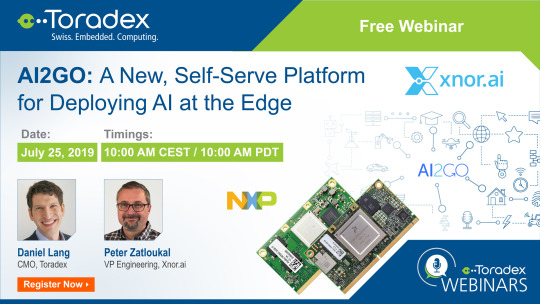
Traditional deep learning models require large amounts of computing power, so deploying at the edge has required either expensive hardware or a constant connection to the cloud. Xnor’s new AI2GO platform enables enterprises and individual developers to easily deploy hyper-efficient deep learning models onto edge devices. AI2GO hosts hundreds of Xnor's pre-trained AI models that are tuned for specific hardware targets, use cases, and performance characteristics to fit different needs. There are a variety of models for computer vision tasks like object and person detection, image segmentation, and action classification, that run on a selection of low power hardware such as the Toradex Apalis System on Module with the NXP® i.MX 6 and i.MX 8 SoCs.
Grab your free registrations now: https://www.toradex.com/webinars/ai2go-a-new-self-serve-platform-for-deploying-ai-at-the-edge
Date and Time:
Europe/Asia - Thursday, July 25, 2019, 2019 10:00 AM - 11:00 AM (CET)
Americas - Thursday, July 25, 2019, 10:00 AM - 11:00 AM (PDT)
Speakers:
Daniel Lang, CMO, Toradex
Peter Zatloukal , VP Engineering, Xnor.ai
Venue: Online Webinar
#Xnor.ai#Toradex#artificial intelligence#edge computing#NXP i.MX6#NXP i.MX8#Apalis System on Modules
0 notes
Text
Introducing Torizon: An Easy-to-use Industrial Linux Platform

Torizon is a brand-new open-source software platform from Toradex that aims to simplify the development and maintenance of embedded Linux Software. Torizon is built on top of a minimal Linux-based, Yocto-compatible Operating System. Torizon comes with built-in support for Docker containers and over-the-air (OTA) updates. It integrates with Visual Studio and Qt, and provides a variety of tools and features to simplify the life of developers.
Key Takeaways:
What is Torizon? Why should you adopt it?
Docker/ Software Containers Introduction
See the out-of-the-box experience
Learn about the over-the-air (OTA) updates using OSTree and Aktualizr
Experience the Microsoft Embedded Developer Environment
Learn how to leverage the Torizon tools, such as Flash Analytics
Grab your free registrations now: https://www.toradex.com/webinars/introducing-torizon-easy-to-use-industrial-linux-platform
Date and Time:
Europe/Asia - Friday, June 07, 2019, 2019 10:00 AM - 11:00 AM (CET)
Americas - Friday, June 07, 2019, 2019 10:00 AM - 11:00 AM (PDT)
Speakers:
Daniel Lang, CMO, Toradex
Valter Minute, Sr. Development Engineer, Toradex
Venue: Online Webinar
0 notes
Text
Toradex IoT Security Tech Day with NXP®, Germany

Join NXP and Toradex in Munich on May 21, 2019, to learn all about NXP’s A71CH: Plug & Trust - The fast, easy way to deploy secure IoT connections. A71CH is a ready-to-use secure element for IoT devices providing a root of trust at the IC level and delivers, chip-to-cloud security right out-of-the-box. Delivered as a ready-to-use solution, the A71CH includes a complete product support package that simplifies design-in and reduces time-to-market.
Features
Secure, zero-touch connectivity
End-to-end security, from chip to edge to cloud
Secure credential injection for root of trust at IC level
Protected access to credentials
Fast design-in with complete product support package
Easy to integrate with different MCU and MPU platforms
Encrypted/authenticated interface to host processor
ECC-based authentication
TLS set-up (TLS-PKI, TLS-PSK)
Connectionless message authentication (HMAC)
Protected storage for product master secrets with key wrapping and key derivation functions, key locking mechanism
Optional trust provisioning by NXP and qualified partners
Standard (-25 to +85 °C, A7101) and extended (-40 to +90 °C, A7102) temp ranges
HVSON8 (4x4 mm) and WLCSP (2x2 mm) package
Venue: Schatzbogen 7, 81829 Munich, Germany
Date: May 21, 2019 from 10:00 to 15:30
For Registration: https://www.toradex.com/events/toradex-iot-security-tech-day-with-nxp-germany-2019
0 notes
Text
Webinar: Managing Devices with Linux Device Drivers
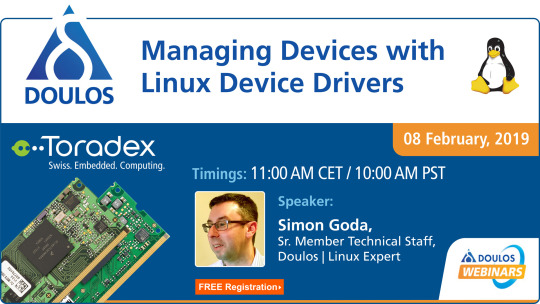
In this webinar we investigate the why and how of managing peripheral devices in an Arm-based embedded Linux system. Although this is a huge and complex subject area, we can still introduce some of the key concepts and start to appreciate the steps involved in writing a device driver.
Content Summary:
How devices are represented in the device-tree description
The basic framework used for a Linux kernel device driver
Fundamentals of device driver programming, including interrupt handling and memory
How devices can be managed from user-space and a comparison with kernel-based management
Some of the tools and techniques available for debugging device drivers.
The webinar has been produced using NXP based iMX SoCs - however the concepts are fully SoC independent.
Grab your free registrations now: https://www.doulos.com/content/events/linux_device_drivers_TDX.php?pk_campaign=TDXWB
Date and Time:
Europe/Asia - Friday, February 08, 2019 11:00 AM - 12:00 PM (CET)
Americas - Friday, February 08, 2019 10:00 AM - 11:00 AM (PST)
Speakers:
Simon Goda, Sr. Member Technical Staff, Doulos
Venue: Online Webinar
0 notes
Text
Joint Webinar: Getting Started with Qt on Toradex System on Modules in no time!
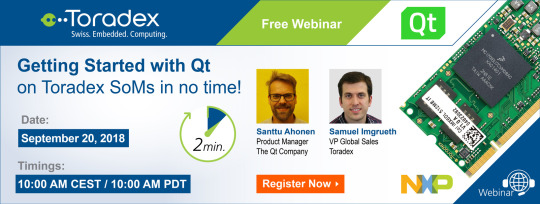
In this webinar from Qt and Toradex, you will learn how simple it is to install Qt on Toradex System on Modules (SoMs). Learn how you can evaluate the performance in less than 2 minutes! Next, we will take you through the simple steps to install Qt Device Creation, develop your first Hello World and deploy and debug it directly on the Colibri iMX6 SoM with the NXP i.MX 6 DualLite SoC.
Grab your free registrations now: https://www.toradex.com/webinars/guest-webinar-getting-started-with-qt-on-toradex-system-on-modules-in-no-time
Date and Time:
Slot 1 - Thursday, September 20, 2018 10:00 AM - 11:00 AM (CET)
Slot 2 - Thursday, September 20, 2018 10:00 AM - 11:00 AM (PDT)
Speakers:
Santtu Ahonen, Product Manager, The Qt Company
Samuel Imgrueth, VP Global Sales, Toradex
Venue: Online Webinar
#Toradex Webinar#Getting Started with Qt#Qt Framework#Colibri iMX6#NXP i.MX 6 DualLite SoC#iMX6 System on Module#iMX6 Computer on Module#iMX6 SoM#iMX6 CoM
0 notes
Text
Amazon FreeRTOS, heterogeneous cores and the all-new Apalis and Colibri iMX8
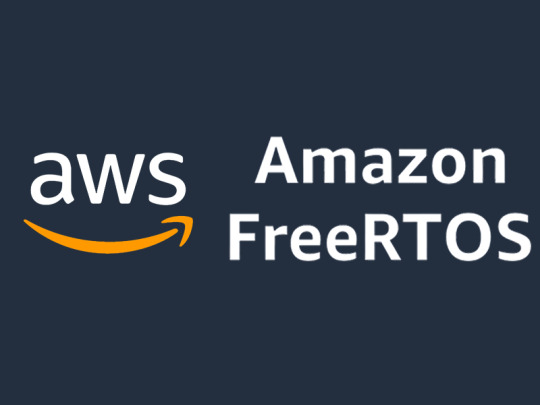
Amazon acquires FreeRTOS FreeRTOS is a real-time operating system kernel for embedded devices. In development since 2003, it is the market-leading real-time operating system, having been ported to more than 40 microcontroller architectures. On November 29, 2017, Amazon acquired FreeRTOS and announced Amazon FreeRTOS (or a:FreeRTOS), a real-time operating system kernel based on FreeRTOS and focused on low-power, connected devices.
Amazon seems to be interested in integrating the most widely used real-time operating system — which, consequently, has a very broad user base — with their cloud services, like AWS IoT Core and AWS Greengrass. After the acquisition, Amazon introduced version 10 of FreeRTOS. Along with new features like cloud and edge connectivity libraries, the kernel license was changed from a modified version of the GNU General Public License (GPL), which the FreeRTOS project used previously, to the more permissive MIT license. This means that FreeRTOS is still a separate product and can be used freely, with or without Amazon services.
Why this is relevant: Heterogeneous Multicore Processing (HMP)
Toradex offers the Colibri iMX7 and Colibri VF61 System on Modules (SoMs) / Computer on Modules (CoMs). These products are based on the NXP® i.MX7 and Vybrid SoC respectively. The processors on these modules feature an Arm® Cortex-A core, usually running an operating system such as embedded Linux; and an Arm Cortex-M4 microcontroller core, which can run bare-metal code or a real-time operating system like FreeRTOS. Here's an outline of use cases:
Control systems: The Cortex-M4 core can be used as a controller for a dynamic system, running, e.g., a PID controller, offloading the Cortex-A core running Linux, which, in turn, could be displaying a human-machine interface.
Data acquisition: On applications that make use of an analog-to-digital converter, the Cortex-M4 core can be employed to acquire data at a high sample rate more easily, also offloading the other core.
An example application using the Toradex Colibri iMX7 System on Module is a self-balancing robot named TAQ. It was developed in partnership with Antmicro and Qt. The robot runs embedded Linux on the Cortex-A7 core, presenting the robot's face animations and sensor data received from the Cortex-M4 core. The Cortex-M4 core runs FreeRTOS, acquiring data from sensors such as an accelerometer and a gyroscope. It uses this data to control the dynamic system, employing a PID controller and a Kalman filter. The cores communicate via RPMsg. A kernel module on the Linux side creates a virtual serial interface which connects to the Cortex-M4; data exchange can be achieved by writing to or reading from this serial device, just as it would be done with a "real" serial device.
The sources for this demo are open and can be found here (Linux side, user interface) and here (Cortex-M4 firmware).
The Toradex Colibri iMX7 was also used on a tablet demonstrating some low-power applications. This video showcases the demo, which features sensor data acquisition and visualization while independently displaying power consumption on a separate LCD display.
Toradex supports and maintains a FreeRTOS repository for its System on Modules. Many peripheral drivers and examples are included and ready to use. Some documentation is available at the Toradex Developer Center showing how you can get up and running with the built-in FreeRTOS examples. Watch our webinars for deeper insight into heterogeneous multicore systems development.
youtube
youtube
What about the future?
On the software side
There are many new players in the RTOS market. In 2016, Wind River Systems and the Linux Foundation launched Zephyr, a real-time operating system also focused on small, connected devices, targeting the IoT market. The Toradex Colibri iMX7 System on Module is officially supported by Zephyr, and development is ongoing.
On the hardware side: the all-new NXP i.MX 8-based Apalis and Colibri SoMs
Toradex has just launched the early access phase of its brand-new System on Module, the Apalis iMX8. This powerful SoM is based on the NXP i.MX 8QuadMax (i.MX 8QM) applications processor, featuring two Arm Cortex-A72 cores, four Cortex-A53 cores and two Cortex-M4 cores. Packed with 4 GB of LPDDR4 RAM and 16GB of eMMC flash storage, it also has built-in dual band Wi-Fi (802.11ac) and Bluetooth (Bluetooth 5-ready). This System on Module is ideal for computer vision applications: there are two integrated Vivante GC7000 GPUs, supporting Vulkan and OpenGL ES.
The two Cortex-M4 cores open up many possibilities: as an example, you can run two different applications or real-time operating systems independently, to balance a data processing application; or use one core for sensor data acquisition and the other for post-processing. The microcontroller cores can also be used as a safety fallback for a graphical display, or to present early boot animations instead of static images.
Toradex presented an Apalis iMX8 demo at Embedded World 2018. Watch this video to check it out, along with some other exciting partner demos.
Soon: Colibri iMX8
The Colibri family is also slated to receive an update: Toradex will soon launch its Colibri iMX8 System on Module. Based on the NXP i.MX 8X, it will also feature a heterogeneous multicore architecture, with a Cortex-M4 core and a Cortex-A35 core running side by side. Stay tuned for more information on this upcoming System on Module!
#Amazon web services#FreeRTOS#Amazon FreeRTOS#System on Modules#heterogeneous multi-core processor#nxp i.mx 8quadmax#NXP i.MX 7#NXP VF61
0 notes
Text
Guest Webinar: Heterogeneous Multiprocessing with Android on NXP i.MX 7

Asymmetric multiprocessing (AMP) systems fulfill the need for high performances and real-time by combining the responsiveness of a MCU (Cortex-M) with the processing power of an application processor which runs a full OS.
This webinar presents a technical overview on asymmetric multiprocessing and its implementation on an NXP i.MX 7 Colibri System on Module running Android on the MPU (Cortex-A, master core) and FreeRTOS on the MCU (Cortex-M, real-time core).
Grab your free registrations now: https://www.toradex.com/webinars/heterogeneous-multiprocessing-with-android-on-nxp-imx-7
Date and Time:
Slot 1 - Wednesday, June 06, 2018 11:00 AM - 12:00 PM (CET)
Slot 2 - Wednesday, June 06, 2018 10:00 AM - 11:00 AM (PDT)
Speakers:
Nicola La Gloria, CEO, Kynetics
Laura Nao, Embedded Engineer, Kynetics
Stefan Eichenberger, Field Application Engineer, Toradex AG
Venue: Online Webinar
#Toradex Webinar#Heterogeneous Multiprocessing#Colibri iMX7#NXP i.MX 7#Android#FreeRTOS#iMX7 System on Module#iMX7 Computer on Module
0 notes